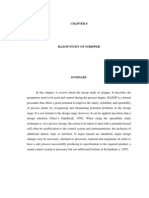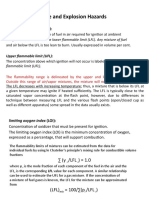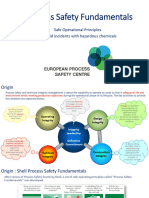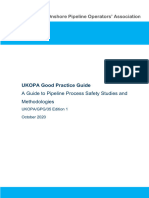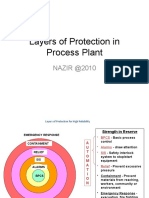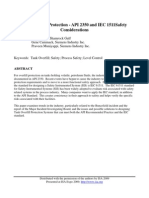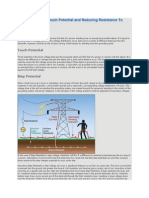Hazop-Gas Processing Complex
Hazop-Gas Processing Complex
Uploaded by
javadCopyright:
Available Formats
Hazop-Gas Processing Complex
Hazop-Gas Processing Complex
Uploaded by
javadOriginal Description:
Copyright
Available Formats
Share this document
Did you find this document useful?
Is this content inappropriate?
Copyright:
Available Formats
Hazop-Gas Processing Complex
Hazop-Gas Processing Complex
Uploaded by
javadCopyright:
Available Formats
SEE-TECH: SAFETY-01
Case Study of Hazard and Operability Study (HAZOP) for Plant of Recovering LPG from Natural Gas
1. About Installation
The natural gas is processed to recover LPG, Special boiling Point Solvent (SBP) and Pentane.
2. About Assignment
Hazard and Operability (HAZOP) Study is carried out by examining each part of the plant and
recorded any potential hazard associated with it. The purpose of examination is to identify all
possible deviations from the way the design is expected to work and all hazard associated with
these deviations. In this way HAZOP study helps to find the "weak link" in a plant and to provide
a basis for developing procedural or engineering controls to remove or lessen the risks from the
identified problem area.
HAZOP study involves a set of standardized GUIDEWORDS, which are used to initiate the
discussion in the team. All possible deviations in process parameters in a reactor or a pipeline
are considered to determine their causes and consequences. If a hazard is identified, first the
existing protective measures are analyzed with respect to the intensity of the hazard. If the
protective measures are not adequate, recommendations are given to mitigate the hazard
HAZOP Guide Words & Possible Deviations
Guide Word Deviation
None No forward flow when there should be, i.e., no flow or reverse flow.
More of More of any relevant physical property than there should be, e.g. higher
flow (rate or total quantity), higher temperature, higher pressure, higher
viscosity, etc.
Less of Less of any relevant physical property than there should be for e.g. lower
flow rate or total quantity, lower temperature, lower pressure, etc.
Part of Composition of system different from what it should be, for e.g., change in
rate of components, component missing, etc.
More than More components are present in the system than there should be, for e.g.,
extra phase present (vapor, solid), impurities (air, water, acids, corrosion
products), etc.
Other than What else can happen apart from normal operation, e.g. start-up,
shutdown, up rating, low rate running, alternative operation mode, failure of
plant services, maintenance, catalyst change, etc.
Hazard & Operability Study require prior understanding of the behavior and hazards of the
hazardous chemicals being used in the plant, which mainly include:
Physical & Chemical Properties
Fire & Explosion Characteristics
Toxicological Properties, if any
3. How did we execute?
First HAZOP sheets are prepared and then the team discusses on possibilities of occurrence of
various deviations from the intended operating conditions by employing the Guidewords;
thereafter response of the control equipments for these deviations is analyzed. Then,
consequences of the deviations are examined for vulnerability towards occurrence of unsafe
situations and suggestions are made to improve system reliability, only if required.
For HAZOP sheet preparation, the variable parameters like pressure, temperature, flow,
concentration are considered. And each variable is considered for each equipment/process by
applying the above guidewords wherever applicable.
Example of HAZOP sheet preparation on Feed Gas Chiller on one variable and guideword (i.e.
Variable- flow and guideword No)
Parameter Guide
Words
(deviat
ion)
Possible causes Possible
consequences
Measures/Existing facilities
safeguard
Action/
Corrective
Measures
Required
Flow of
gas from
chiller
No 1. Gate valve
provided in out
put line of filter
may close.
1. Operability
problem.
2. Filter may get
damage.
3. Level in separator
I decreases.
4. Less temperature
of liquid feed to the
LEF column.
1. Pressure gauge-1203 are provided
in out put pipe line of filter.
2. Differential pressure transmitter -
1301/1302 on chiller.
3. Differential pressure alarm high
PDAH-1301/1302
4. Level alarm low low LALL-1302,
1303
5. Temperature element
1301,1305,1303, 1302.
6. Temperature indicator 1301
7. Temperature alarm low low TALL-
1303/1302
5. Recommendations
1. All the Measuring instruments should be regularly maintained and periodically calibrated so that
reading will be visible and measurable.
2. The colour coding for all pipeline should be properly done and should be specific for each
product to prevent any confusion.
3. Acid storage and handling area should be regularly checked for corrosion, leakages etc and
should be properly maintained.
4. Equipment (either manual or working)manual should be available to the concerned persons.
5. Weeds, grass, shrubs or any combustible material should be removed from the plant premises
in order to avoid spreading of fire , during any fire hazard.
6. Electrical Cable conduits should be periodically checked and maintained properly.
7. During loading operation in Tank Truck shed earthing should be strictly followed to prevent from
static electricity hazard.
8. Redundant pipelines (2 HDPE Pipeline) present in acid dosing areas should be removed from
the plant to avoid confusion. And newly installed SS Pipeline should be properly clamped.
9. The plant was well maintained and same is recommended for future also to prevent the any
disaster.
SEE- Tech Solutions Pvt. Ltd
Solution Providers for Energy Conservation & Plant Safety Improvement
Lets Conserve, 11/5, MIDC Infotech Park, Near VRCE Telephone Exchange,
South Ambazari Road, NAGPUR - 440 022, (INDIA)
Tele: +91-712-2222177, Fax +91-712-2225293,
E-Mail: seemil_ngp@sancharnet.in Web: www.letsconserve.org
You might also like
- HAZOP STUDY Report (Kutch Chemical Industries Limited)Document82 pagesHAZOP STUDY Report (Kutch Chemical Industries Limited)kanakarao173% (11)
- HAZOP Budgeting Tool: Practical Solutions For Today's HSE ChallengesDocument2 pagesHAZOP Budgeting Tool: Practical Solutions For Today's HSE ChallengesifalerinNo ratings yet
- Hazop StudyDocument7 pagesHazop StudyAnderson JoeNo ratings yet
- Process Hazard Analysis: Faculty of Chemical Engineering Universiti Teknologi MaraDocument30 pagesProcess Hazard Analysis: Faculty of Chemical Engineering Universiti Teknologi MaraSalihin FhooziNo ratings yet
- Hazard and Operability StudiesDocument8 pagesHazard and Operability Studiesangry_granNo ratings yet
- CHAPTER 8 Hazop StudyDocument7 pagesCHAPTER 8 Hazop StudyNethiyaa50% (2)
- A Report On HAZOP AnalysisDocument15 pagesA Report On HAZOP AnalysisachyutNo ratings yet
- Dynamic Depressurisation Calculations LNG Regasification UnitDocument15 pagesDynamic Depressurisation Calculations LNG Regasification Unitilmu2No ratings yet
- Diference Between HAZID and HAZOPDocument2 pagesDiference Between HAZID and HAZOPQueziaNo ratings yet
- Explosion Risk Analysis ERA' For FLNG Facilities: The Main ChallengesDocument6 pagesExplosion Risk Analysis ERA' For FLNG Facilities: The Main ChallengesAndro SiregarNo ratings yet
- Chapter 6: Mitigating Hazards Via A Process Safety Management SystemDocument20 pagesChapter 6: Mitigating Hazards Via A Process Safety Management SystemGiancarloErrigoNo ratings yet
- Inherently Safer DesignDocument64 pagesInherently Safer Designsepideh_entezari100% (1)
- Fire and Explosion HazardsDocument11 pagesFire and Explosion HazardsSayed Ibrahim GhanemNo ratings yet
- 13 - 17.09.2020 - Webinar EPSC PS FundamentalsDocument33 pages13 - 17.09.2020 - Webinar EPSC PS FundamentalsRizky100% (2)
- Milestone 2 - HAZOP & HAZAN (Final Completed PDFDocument76 pagesMilestone 2 - HAZOP & HAZAN (Final Completed PDFAneesch PreethaNo ratings yet
- Accuracy in QRADocument8 pagesAccuracy in QRAJohm Robert taylor100% (1)
- GAPS Guidelines: Solvent Recovery With Activated CarbonDocument7 pagesGAPS Guidelines: Solvent Recovery With Activated CarbonAsad KhanNo ratings yet
- Process Safety: Are There Proven Tools For ATEX Risk Assessment?Document1 pageProcess Safety: Are There Proven Tools For ATEX Risk Assessment?SARFRAZ ALINo ratings yet
- Intro To HAZID of PipelinesDocument30 pagesIntro To HAZID of Pipelineszohaib_farooq100% (3)
- Atul LTD Risk AssessmentDocument108 pagesAtul LTD Risk AssessmentdevangNo ratings yet
- Correct Hazid ChecklisterDocument16 pagesCorrect Hazid ChecklisterAkintoye AsaoluNo ratings yet
- PROJECT STANDARDS and SPECIFICATIONS Personnel Safety Protective Equipment Rev01Document14 pagesPROJECT STANDARDS and SPECIFICATIONS Personnel Safety Protective Equipment Rev01hiyeonNo ratings yet
- Definition - What Does Hazard Identification Study (HAZID) Mean?Document2 pagesDefinition - What Does Hazard Identification Study (HAZID) Mean?ShirishNo ratings yet
- Safety Instrumented Systems: A Comprehensive E-Learning Course (With Free Online Exam & Certification) OnDocument8 pagesSafety Instrumented Systems: A Comprehensive E-Learning Course (With Free Online Exam & Certification) OnIrfan ShaikNo ratings yet
- Process Control WWTP3Document44 pagesProcess Control WWTP3Arima KouseiNo ratings yet
- Shahrul Nazmi Bin Othman: Process Safety EngineerDocument4 pagesShahrul Nazmi Bin Othman: Process Safety EngineerShahrul Nazmi OthmanNo ratings yet
- HSE Commitment and Policy?Document6 pagesHSE Commitment and Policy?radhesrikrishnaNo ratings yet
- Design & Simulation (Assign 4)Document11 pagesDesign & Simulation (Assign 4)Saad AhmedNo ratings yet
- Safety Instrumented Systems SummersDocument19 pagesSafety Instrumented Systems SummersOussama AbderrahimNo ratings yet
- E BookDocument522 pagesE BookGiancarloErrigoNo ratings yet
- Chemical Reactor Inherent Safety Index A PDFDocument9 pagesChemical Reactor Inherent Safety Index A PDFAnilNo ratings yet
- PROTEGO Correct Application of Flame Arresters March 2021Document76 pagesPROTEGO Correct Application of Flame Arresters March 2021Pablo HerreroNo ratings yet
- Function 1 - V-7501 Degasser Pressure HHDocument11 pagesFunction 1 - V-7501 Degasser Pressure HHMuhammad.SaimNo ratings yet
- Preventing The Next Major Incident - OGP Safety Workshop Summary 363Document18 pagesPreventing The Next Major Incident - OGP Safety Workshop Summary 363Deepak RajoriaNo ratings yet
- GPG35 Pipeline Process Safety Studies and Methodologies Ed 1Document38 pagesGPG35 Pipeline Process Safety Studies and Methodologies Ed 1snikraftar1406No ratings yet
- Chemical Reactivity HazardsDocument101 pagesChemical Reactivity HazardsSandeep VermaNo ratings yet
- Chlorine Hazard ManagementDocument30 pagesChlorine Hazard Managementpriyank gamiNo ratings yet
- Layers of Protection in Process Plant: NAZIR @2010Document41 pagesLayers of Protection in Process Plant: NAZIR @2010Muhammad NazirNo ratings yet
- Hazid Hazop Sil TorDocument23 pagesHazid Hazop Sil Tormohamed senoussiNo ratings yet
- FRED - QRA - Consequence Modelling - Learnings From QRA - Overview of HazardsDocument75 pagesFRED - QRA - Consequence Modelling - Learnings From QRA - Overview of HazardsJohn Obidi0% (1)
- Jepg ... SJEC - Jan 2023 Module On PROCESS SAFETYDocument20 pagesJepg ... SJEC - Jan 2023 Module On PROCESS SAFETYL JayanthiNo ratings yet
- Essential Standard 29 - Safe Isolation of Plant and EquipmentDocument8 pagesEssential Standard 29 - Safe Isolation of Plant and EquipmentOmarSayedNo ratings yet
- User-Manual-25262Compressed Gas Cylinders PowerPointDocument20 pagesUser-Manual-25262Compressed Gas Cylinders PowerPointMohammed NaseeruddinNo ratings yet
- SA 01 Phast Training - tcm8 8859 PDFDocument1 pageSA 01 Phast Training - tcm8 8859 PDFU.G.No ratings yet
- Philosophy of HSEDocument1 pagePhilosophy of HSEAmir Zad KhanNo ratings yet
- Ehs Weekly Data Report: Company: Pt. Viking - Day Shift Period 8-14NOV 2019Document1 pageEhs Weekly Data Report: Company: Pt. Viking - Day Shift Period 8-14NOV 2019Sanjay Kumar GhadaiNo ratings yet
- Anhydrous Ammonia SafetyDocument33 pagesAnhydrous Ammonia SafetyYaltiNo ratings yet
- Safety Training Presentations: Process Safety Management of Highly Hazardous Chemicals 29 CFR 1910.119 (PSM) EH&S 3-13Document22 pagesSafety Training Presentations: Process Safety Management of Highly Hazardous Chemicals 29 CFR 1910.119 (PSM) EH&S 3-13Billel Hichem HitacheNo ratings yet
- The Use of Hazop Techniques in Applied Hazard ProcessesDocument72 pagesThe Use of Hazop Techniques in Applied Hazard Processesamidi5555913No ratings yet
- Journey To ALARPDocument52 pagesJourney To ALARPJNo ratings yet
- Honeywell Whitepaper-Optimizing-ProcessSafetyDocument12 pagesHoneywell Whitepaper-Optimizing-ProcessSafetyLeoPérezNo ratings yet
- Tank Overfill Protection - API 2350 and IEC 1511safety ConsiderationsDocument10 pagesTank Overfill Protection - API 2350 and IEC 1511safety ConsiderationsAyanleh Idriss HassanNo ratings yet
- 170630-1201 MultiPoint-Flare-SS FINAL JZHCDocument4 pages170630-1201 MultiPoint-Flare-SS FINAL JZHCManajemen Gas UI 2018No ratings yet
- BMB & CKD MCD VaDocument6 pagesBMB & CKD MCD VaFazrulNo ratings yet
- Bestpractices RIL Jamnagar MR WaghuldeFILEminimizerDocument15 pagesBestpractices RIL Jamnagar MR WaghuldeFILEminimizerArun Kumar KarNo ratings yet
- General Standard: IPS-G-ME-100Document40 pagesGeneral Standard: IPS-G-ME-100Renalyn TorioNo ratings yet
- Fertil Hazop StudyDocument9 pagesFertil Hazop Studypkannan0% (1)
- Hazard and Operability Studies (HAZOP)Document28 pagesHazard and Operability Studies (HAZOP)anpuselvi125100% (1)
- 2 4 HazopDocument14 pages2 4 HazopIMPG077080No ratings yet
- Guidelines For Subsea Pipeline Cathodic Protection SurveyDocument38 pagesGuidelines For Subsea Pipeline Cathodic Protection SurveyjavadNo ratings yet
- Earthling System Electrical and Instruments Test ProcedureDocument23 pagesEarthling System Electrical and Instruments Test Procedurejavad100% (1)
- Crest FactorDocument3 pagesCrest FactorjavadNo ratings yet
- Nema Motor Frame SizesDocument4 pagesNema Motor Frame Sizesjavad100% (2)
- 4 Ways in Which Noise Can Enter A Signal Cable and Its ControlDocument5 pages4 Ways in Which Noise Can Enter A Signal Cable and Its ControljavadNo ratings yet
- Earthing SchematicDocument36 pagesEarthing SchematicjavadNo ratings yet
- China Floating Roof TanksDocument4 pagesChina Floating Roof TanksjavadNo ratings yet
- Sizing of Power Cables For Circuit Breaker Controlled Feeders Part IDocument6 pagesSizing of Power Cables For Circuit Breaker Controlled Feeders Part IjavadNo ratings yet
- What Is Step and Touch Potential and Reducing Resistance To GroundDocument4 pagesWhat Is Step and Touch Potential and Reducing Resistance To GroundjavadNo ratings yet
- Condition Assessment of HVDocument290 pagesCondition Assessment of HVjavad100% (1)
- Winding Pitch-1 PDFDocument12 pagesWinding Pitch-1 PDFlimkokchiang809100% (1)
- Flare Design CriteriaDocument7 pagesFlare Design Criteriamujidah27100% (1)
- Hi Direct 2008 CatalogDocument84 pagesHi Direct 2008 CatalogjavadNo ratings yet
- Direct Current Field Test1Document5 pagesDirect Current Field Test1javadNo ratings yet
- Genset Load TestDocument10 pagesGenset Load Testjavad100% (2)





